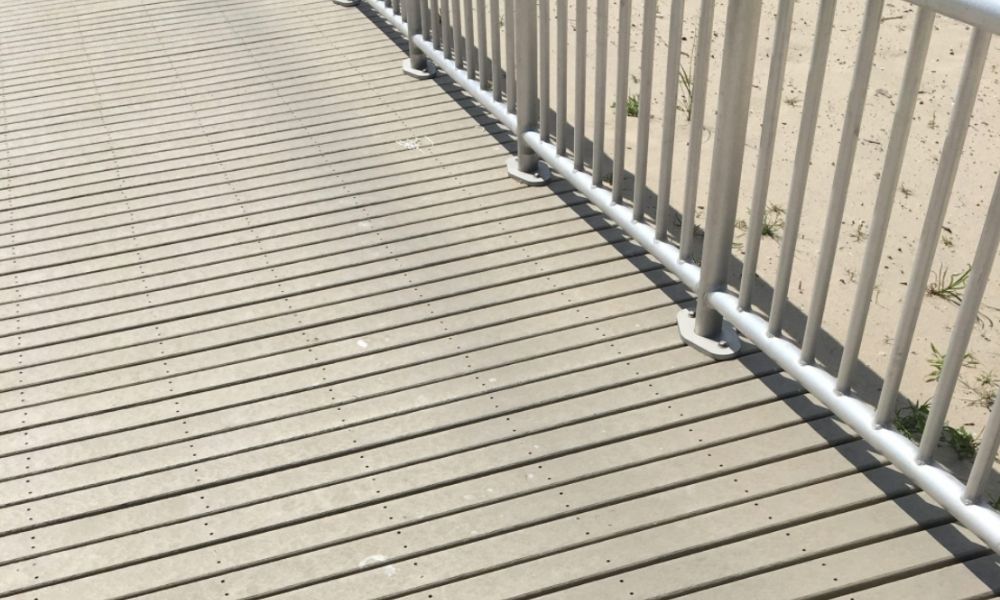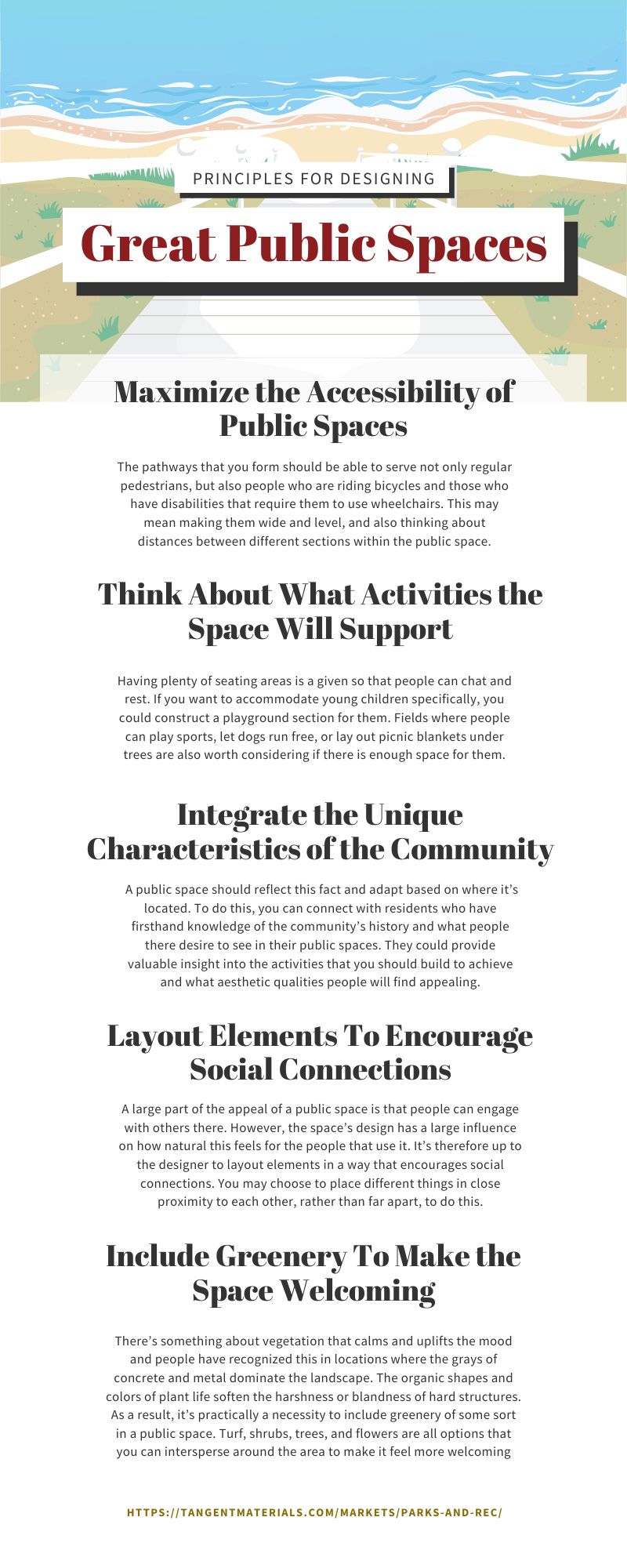Principles for Designing Great Public Spaces

Public spaces can come in various shapes and sizes, but their overall purposes are consistent. They serve to increase the wellness of people who live nearby by providing spaces to relax and enjoy the outdoors, exercise, and socialize. In urban environments, they provide a much-needed reprieve from the hustle and bustle of the city. For public spaces to be successful, a great deal of systematic consideration must go into their layouts. They need to possess friendly atmospheres and fulfill practical needs as well. Refer to these principles for designing great public spaces in order to gain insight into what facets you should pay attention to while planning them.
Maximize the Accessibility of Public Spaces
Since you want everyone in the community to be able to utilize a public space, you should think about how accessible its arrangement is. The pathways that you form should be able to serve not only regular pedestrians, but also people who are riding bicycles and those who have disabilities that require them to use wheelchairs. This may mean making them wide and level, and also thinking about distances between different sections within the public space. Although winding pathways can be nice for those that want to savor their time, you shouldn’t include them exclusively. Straighter paths that allow for faster movement should also exist so that it’s easy for people to get from one place to the other when they want to.
Think About What Activities the Space Will Support
Public spaces can differ greatly in appearances and usage, so a principle for designing great public spaces it to determine what kinds of activities that they will support. Having plenty of seating areas is a given so that people can chat and rest. If you want to accommodate young children specifically, you could construct a playground section for them. Fields where people can play sports, let dogs run free, or lay out picnic blankets under trees are also worth considering if there is enough space for them. Basketball courts can become major attractions for a public space as well. A diversity of potential activities will let people of all ages enjoy the area, and thus, you should try to keep many activities in mind while designing.
Integrate the Unique Characteristics of the Community
Every community has its own unique heritage and values. A public space should reflect this fact and adapt based on where it’s located. To do this, you can connect with residents who have firsthand knowledge of the community’s history and what people there desire to see in their public spaces. They could provide valuable insight into the activities that you should build to achieve and what aesthetic qualities people will find appealing. You can even partner with locals to have them contribute art that will adorn the public space, helping them to relate to it more deeply than if it was cold and generic in nature. Making sure to involve residents in the community in your design process will ensure that the final public space will see frequent use and will become a positive addition that is safe and pleasant to visit.
Layout Elements To Encourage Social Connections
A large part of the appeal of a public space is that people can engage with others there. However, the space’s design has a large influence on how natural this feels for the people that use it. It’s therefore up to the designer to layout elements in a way that encourages social connections. You may choose to place different things in close proximity to each other, rather than far apart, to do this. To illustrate, you could group together several benches or tables so that people who are sitting at them can talk. Making public spaces open rather than overly segmented and enclosed can also help to establish a similarly open and friendly tone that promotes socializing. In addition, it’s important to consider what’s nearby. Perhaps there are some restaurants right next to the public space. You could have seating on the side that is closest to them to make the space more useable and promote more engagement. Design your public spaces with this in mind.
Include Greenery To Make the Space Welcoming
There’s something about vegetation that calms and uplifts the mood and people have recognized this in locations where the grays of concrete and metal dominate the landscape. The organic shapes and colors of plant life soften the harshness or blandness of hard structures. As a result, it’s practically a necessity to include greenery of some sort in a public space. Turf, shrubs, trees, and flowers are all options that you can intersperse around the area to make it feel more welcoming. Utilizing these elements will allow people who venture to the public space to rejuvenate their minds after spending many hours indoors or in parts of their city where greenery is sparse. Plants also help to improve air quality by filtering out pollutants and producing oxygen as a byproduct of photosynthesis. Furthermore, they’re instrumental in helping to regulate temperatures because they absorb less heat and give off cool water vapor through transpiration.
Make Public Spaces Adaptable To Change
Not every characteristic of a public space must be finalized upon its initial design completion. Funding for additional improvements to it can come later on. The buildings, streets, and other community features may also change over time. Due to these factors, you should design public spaces as adaptable to change to make them truly effective in the long run. You can leave much of the area more simplistic at first to give them great versatility. In this way, aiming for adaptability overlaps with encouraging social connections, since wide, open spaces are the most advantageous for flexibility. When people’s needs grow and change, a public space that isn’t overly adorned will then be easy to add new elements to without requiring the tearing down of lots of obsolete structures.
Carefully Consider the Materials That You Use
The building materials that you use for a public space should satisfy a few important requirements. They should be visually appealing, long-lasting, and sustainable. The first aspect will support your efforts to make the public space welcoming to people, while the second will reduce maintenance costs and prevent injuries related to the deterioration of structures there. Sustainability is also significant because you should aim to minimize the negative environmental impact of the space during and after construction.
A material that is perfect for any public space is the plastic lumber that Tangent produces. You can use our HDPE-based plastic lumber to create playground equipment, fences, seats, signs, and trash bins that won’t soften, splinter, fade, or warp completely out of shape when left outside. This is because insects, UV radiation, temperature changes, moisture, and physical forces will not damage the material. You can moreover create reliable retaining walls and borders around trees, shrubs, and flower beds with our recycled plastic landscape timbers due to these features. Plastic lumber is also sustainable because Tangent sources our HDPE from post-consumer waste products, such as milk jugs and laundry detergent containers. So, if you’re interested using this material for your public space project, don’t hesitate to connect with us today.













